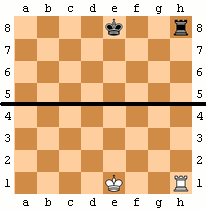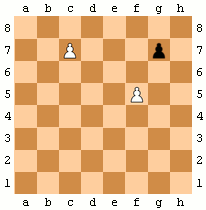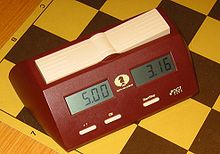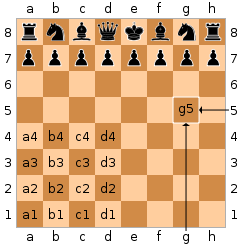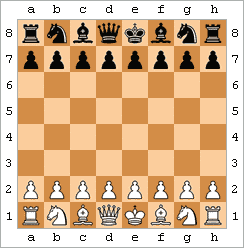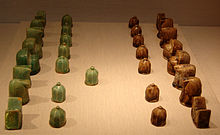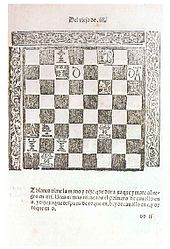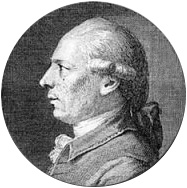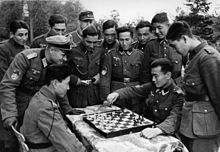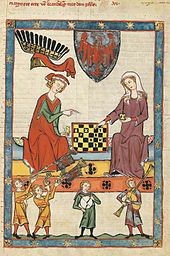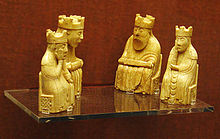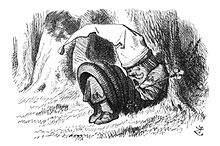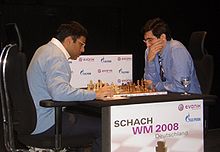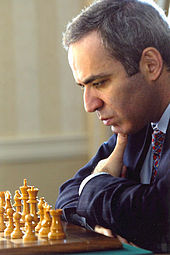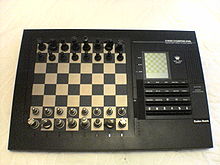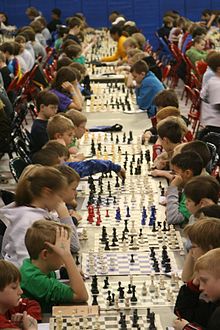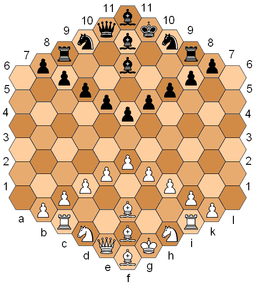
Chess
Background to the schools Wikipedia
SOS Children made this Wikipedia selection alongside other schools resources. SOS Children works in 45 African countries; can you help a child in Africa?
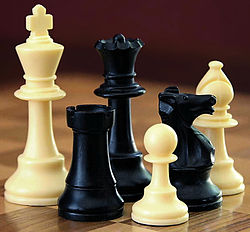 Part of a Staunton chess set (from left to right): a white king, a black rook, a black queen, a white pawn, a black knight, and a white bishop |
|
| Years active | c. 6th century – present |
|---|---|
| Genre(s) | Board game Abstract strategy game |
| Players | 2 |
| Setup time | About 1 minute |
| Playing time | Casual games usually last 10 to 60 minutes; tournament games last anywhere from about ten minutes ( blitz chess) to six hours or more. |
| Random chance | None |
| Skill(s) required | Strategy, tactics |
Chess is a two-player strategy board game played on a chessboard, a checkered gameboard with 64 squares arranged in an eight-by-eight grid. It is one of the world's most popular games, played by millions of people worldwide at home, in clubs, online, by correspondence, and in tournaments.
Each player begins the game with 16 pieces: one king, one queen, two rooks, two knights, two bishops, and eight pawns. Each of the six piece types moves differently. Pieces are used to attack and capture the opponent's pieces, with the objective to ' checkmate' the opponent's king by placing it under an inescapable threat of capture. In addition to checkmate, the game can be won by the voluntary resignation of the opponent, which typically occurs when too much material is lost, or if checkmate appears unavoidable. A game may also result in a draw in several ways, where neither player wins. The course of the game is divided into three phases: opening, middlegame, and endgame.
The first official World Chess Champion, Wilhelm Steinitz, claimed his title in 1886; the current World Champion is Indian chess Grandmaster Viswanathan Anand. In addition to the World Championship, there are the Women's World Championship, the Junior World Championship, the World Senior Championship, the Correspondence Chess World Championship, the World Computer Chess Championship, and Blitz and Rapid World Championships. The Chess Olympiad is a popular competition among teams from different nations. Online chess has opened amateur and professional competition to a wide and varied group of players. Chess is a recognized sport of the International Olympic Committee and international chess competition is sanctioned by the World Chess Federation (FIDE), which adopted the now-standard Staunton chess set in 1924 for use in all official games. There are also many chess variants, with different rules, different pieces, and different boards.
Since the second half of the 20th century, computers have been programmed to play chess with increasing success, to the point where home computers can play chess at a very high level. In the past two decades computer analysis has contributed significantly to chess theory, particularly in the endgame. The computer Deep Blue was the first machine to overcome a reigning World Chess Champion in a match, when it defeated Garry Kasparov in 1997.
Rules
The official rules of chess are maintained by the World Chess Federation. Along with information on official chess tournaments, the rules are described in the FIDE Handbook, Laws of Chess section.
Setup
Chess is played on a square board of eight rows (called ranks and denoted with numbers 1 to 8) and eight columns (called files and denoted with letters a to h) of squares. The colors of the 64 squares alternate and are referred to as "light squares" and "dark squares". The chessboard is placed with a light square at the right-hand end of the rank nearest to each player, and the pieces are set out as shown in the diagram, with each queen on its own colour.
The pieces are divided, by convention, into white and black sets. The players are referred to as "White" and "Black", and each begins the game with 16 pieces of the specified colour. These consist of one king, one queen, two rooks, two bishops, two knights, and eight pawns.
Movement
White always moves first. After the initial move, the players alternately move one piece at a time (with the exception of castling, when two pieces are moved). Pieces are moved to either an unoccupied square or one occupied by an opponent's piece, which is captured and removed from play. With the sole exception of en passant, all pieces capture opponent's pieces by moving to the square that the opponent's piece occupies. A player may not make any move that would put or leave his king under attack. If the player to move has no legal moves, the game is over; it is either a checkmate (a loss for the player with no legal moves)—if the king is under attack—or a stalemate (a draw)—if the king is not.
Each chess piece has its own style of moving. In the diagrams, the dots mark the squares where the piece can move if no other pieces (including one's own piece) are on the squares between the piece's initial position and its destination.
- The king moves one square in any direction. The king has also a special move which is called castling and involves also moving a rook.
- The rook can move any number of squares along any rank or file, but may not leap over other pieces. Along with the king, the rook is involved during the king's castling move.
- The bishop can move any number of squares diagonally, but may not leap over other pieces.
- The queen combines the power of the rook and bishop and can move any number of squares along rank, file, or diagonal, but it may not leap over other pieces.
- The knight moves to any of the closest squares that are not on the same rank, file, or diagonal, thus the move forms an "L"-shape: two squares vertically and one square horizontally, or two squares horizontally and one square vertically. The knight is the only piece that can leap over other pieces.
- The pawn may move forward to the unoccupied square immediately in front of it on the same file; or on its first move it may advance two squares along the same file provided both squares are unoccupied; or it may move to a square occupied by an opponent's piece which is diagonally in front of it on an adjacent file, capturing that piece. The pawn has two special moves: the en passant capture and pawn promotion.
* Pawns can optionally move two squares forward instead of one on their first move only. They capture diagonally (black "x"s); they cannot capture with their normal move (black "●"s). Pawns also are involved in the special capture called en passant.
Castling
Once in every game, each king is allowed to make a special move, known as castling. Castling consists of moving the king two squares along the first rank toward a rook (which is on the player's first rank) and then placing the rook on the last square the king has just crossed. Castling is permissible only if all of the following conditions hold:
- Neither of the pieces involved in castling may have been previously moved during the game.
- There must be no pieces between the king and the rook.
- The king may not be in check, nor may the king pass through squares that are under attack by enemy pieces, nor move to a square where it is in check.
En passant
When a pawn advances two squares from its starting position and there is an opponent's pawn on an adjacent file next to its destination square, then the opponent's pawn can capture it en passant (in passing), and move to the square the pawn passed over. However, this can only be done on the very next move, otherwise the right to do so is forfeit. For example, if the black pawn has just advanced two squares from g7 (initial starting position) to g5, then the white pawn on f5 may take it via en passant on g6 (but only on white's next move).
Promotion
When a pawn advances to the eighth rank, as a part of the move it is promoted and must be exchanged for the player's choice of queen, rook, bishop, or knight of the same colour. Usually, the pawn is chosen to be promoted to a queen, but in some cases another piece is chosen; this is called underpromotion. In the diagram on the right, the pawn on c7 can be advanced to the eighth rank and be promoted to an allowed piece. There is no restriction placed on the piece that is chosen on promotion, so it is possible to have more pieces of the same type than at the start of the game (for example, two queens).
Check
When a king is under immediate attack by one or two of the opponent's pieces, it is said to be in check. A response to a check is a legal move if it results in a position where the king is no longer under direct attack (that is, not in check). This can involve capturing the checking piece; interposing a piece between the checking piece and the king (which is possible only if the attacking piece is a queen, rook, or bishop and there is a square between it and the king); or moving the king to a square where it is not under attack. Castling is not a permissible response to a check. The object of the game is to checkmate the opponent; this occurs when the opponent's king is in check, and there is no legal way to remove it from attack. It is illegal for a player to make a move that would put or leave his own king in check.
End of the game
Although the objective of the game is to checkmate the opponent, chess games do not have to end in checkmate—either player may resign which is a win for the other player. It is considered bad etiquette to continue playing when in a truly hopeless position. If it is a game with time control, a player may run out of time and lose, even with a much superior position. Games also may end in a draw (tie). A draw can occur in several situations, including draw by agreement, stalemate, threefold repetition of a position, the fifty-move rule, or a draw by impossibility of checkmate (usually because of insufficient material to checkmate). As checkmate from some positions cannot be forced in fewer than 50 moves (such as in the pawnless chess endgame and two knights endgame), the fifty-move rule is not applied everywhere, particularly in correspondence chess.
Time control
Chess matches may also be played with a time control, mostly by club and professional players. If a player's time runs out before the game is completed, the game is automatically lost (provided his opponent has enough pieces left to deliver checkmate). The duration of a game ranges from long games played up to seven hours to shorter rapid chess games, usually lasting 30 minutes or one hour per game. Even shorter is blitz chess, with a time control of three to 15 minutes for each player, and bullet chess (under three minutes). In tournament play, time is controlled using a game clock that has two displays, one for each player's remaining time.
Notation for recording moves
Chess games and positions are recorded using a special notation, most often algebraic chess notation. Abbreviated (or short) algebraic notation generally records moves in the format "abbreviation of the piece moved – file where it moved – rank where it moved". For example, Qg5 means "queen moves to the g-file and 5th rank" (that is, to the square g5). If there are two pieces of the same type that can move to the same square, one more letter or number is added to indicate the file or rank from which the piece moved, e.g. Ngf3 means "knight from the g-file moves to the square f3". The letter P indicating a pawn is not used, so that e4 means "pawn moves to the square e4".
If the piece makes a capture, "x" is inserted before the destination square. Thus Bxf3 means "bishop captures on f3". When a pawn makes a capture, the file from which the pawn departed is used in place of a piece initial, and ranks may be omitted if unambiguous. For example, exd5 (pawn on the e-file captures the piece on d5) or exd (pawn on the e-file captures a piece somewhere on the d-file).
If a pawn moves to its last rank, achieving promotion, the piece chosen is indicated after the move, for example e1Q or e1=Q. Castling is indicated by the special notations 0-0 for kingside castling and 0-0-0 for queenside castling. An en passant capture is sometimes marked with the notation "e.p." A move that places the opponent's king in check usually has the notation "+" added. Checkmate can be indicated by "#" (occasionally "++", although this is sometimes used for a double check instead). At the end of the game, "1–0" means "White won", "0–1" means "Black won", and "½–½" indicates a draw.
Chess moves can be annotated with punctuation marks and other symbols. For example "!" indicates a good move, "!!" an excellent move, "?" a mistake, "??" a blunder, "!?" an interesting move that may not be best, or "?!" a dubious move that is not easily refuted.
For example, one variant of a simple trap known as the Scholar's mate (see animated diagram) can be recorded:
- 1. e4 e5
- 2. Qh5?! Nc6
- 3. Bc4 Nf6??
- 4. Qxf7# 1–0
Strategy and tactics
Chess strategy consists of setting and achieving long-term positioning advantages during the game – for example, where to place different pieces – while tactics concentrate on immediate maneuver. These two parts of the chess-playing process cannot be completely separated, because strategic goals are mostly achieved by the means of tactics, while the tactical opportunities are based on the previous strategy of play. A game of chess is normally divided into three phases: opening, typically the first 10 moves, when players move their pieces to useful positions for the coming battle; then middlegame; and last the endgame, when most of the pieces are gone, kings typically take a more active part in the struggle, and pawn promotion is often decisive.
Fundamentals of tactics
In chess, tactics in general concentrate on short-term actions – so short-term that they can be calculated in advance by a human player or by a computer. The possible depth of calculation depends on the player's ability. In quiet positions with many possibilities on both sides, a deep calculation is more difficult and may not be practical, while in "tactical" positions with a limited number of forced variations, strong players can calculate long sequences of moves.
Simple one-move or two-move tactical actions – threats, exchanges of material, and double attacks – can be combined into more complicated combinations, sequences of tactical maneuvers that are often forced from the point of view of one or both players. Theoreticians describe many elementary tactical methods and typical maneuvers; for example, pins, forks, skewers, batteries, discovered attacks (especially discovered checks), zwischenzugs, deflections, decoys, sacrifices, underminings, overloadings, and interferences.
A forced variation that involves a sacrifice and usually results in a tangible gain is called a combination. Brilliant combinations – such as those in the Immortal Game – are considered beautiful and are admired by chess lovers. A common type of chess exercise, aimed at developing players' skills, is showing players a position where a decisive combination is available and challenging them to find it.
Fundamentals of strategy
Chess strategy is concerned with evaluation of chess positions and with setting up goals and long-term plans for the future play. During the evaluation, players must take into account numerous factors such as the value of the pieces on the board, control of the centre and centralization, the pawn structure, king safety, and the control of key squares or groups of squares (for example, diagonals, open files, and dark or light squares).
The most basic step in evaluating a position is to count the total value of pieces of both sides. The point values used for this purpose are based on experience; usually pawns are considered worth one point, knights and bishops about three points each, rooks about five points (the value difference between a rook and a bishop or knight being known as the exchange), and queens about nine points. The king is more valuable than all of the other pieces combined, since its checkmate loses the game. But in practical terms, in the endgame the king as a fighting piece is generally more powerful than a bishop or knight but less powerful than a rook. These basic values are then modified by other factors like position of the piece (for example, advanced pawns are usually more valuable than those on their initial squares), coordination between pieces (for example, a pair of bishops usually coordinate better than a bishop and a knight), or the type of position (knights are generally better in closed positions with many pawns while bishops are more powerful in open positions).
Another important factor in the evaluation of chess positions is the pawn structure (sometimes known as the pawn skeleton), or the configuration of pawns on the chessboard. Since pawns are the least mobile of the chess pieces, the pawn structure is relatively static and largely determines the strategic nature of the position. Weaknesses in the pawn structure, such as isolated, doubled, or backward pawns and holes, once created, are often permanent. Care must therefore be taken to avoid these weaknesses unless they are compensated by another valuable asset (for example, by the possibility of developing an attack).
Phases
Opening
A chess opening is the group of initial moves of a game (the "opening moves"). Recognized sequences of opening moves are referred to as openings and have been given names such as the Ruy Lopez or Sicilian Defence. They are catalogued in reference works such as the Encyclopaedia of Chess Openings. There are dozens of different openings, varying widely in character from quiet positional play (for example, the Réti Opening) to very aggressive (the Latvian Gambit). In some opening lines, the exact sequence considered best for both sides has been worked out to more than 30 moves. Professional players spend years studying openings and continue doing so throughout their careers, as opening theory continues to evolve.
The fundamental strategic aims of most openings are similar:
- Development: This is the technique of placing the pieces (particularly bishops and knights) on useful squares where they will have an optimal impact on the game.
- Control of the centre: Control of the central squares allows pieces to be moved to any part of the board relatively easily, and can also have a cramping effect on the opponent.
- King safety: It is critical to keep the king safe from dangerous possibilities. A correctly timed castling can often enhance this.
- Pawn structure: Players strive to avoid the creation of pawn weaknesses such as isolated, doubled, or backward pawns, and pawn islands – and to force such weaknesses in the opponent's position.
Most players and theoreticians consider that White, by virtue of the first move, begins the game with a small advantage. This initially gives White the initiative. Black usually strives to neutralize White's advantage and achieve equality, or to develop dynamic counterplay in an unbalanced position.
Middlegame
The middlegame is the part of the game which starts after the opening. There is no clear line between the opening and the middlegame, but typically the middlegame will start when most pieces have been developed. (Similarly, there is no clear transition from the middlegame to the endgame; see start of the endgame.) Because the opening theory has ended, players have to form plans based on the features of the position, and at the same time take into account the tactical possibilities of the position. The middlegame is the phase in which most combinations occur. Combinations are a series of tactical moves executed to achieve some gain. Middlegame combinations are often connected with an attack against the opponent's king; some typical patterns have their own names; for example, the Boden's Mate or the Lasker–Bauer combination.
Specific plans or strategic themes will often arise from particular groups of openings which result in a specific type of pawn structure. An example is the minority attack, which is the attack of queenside pawns against an opponent who has more pawns on the queenside. The study of openings is therefore connected to the preparation of plans that are typical of the resulting middlegames.
Another important strategic question in the middlegame is whether and how to reduce material and transition into an endgame (i.e. simplify). Minor material advantages can generally be transformed into victory only in an endgame, and therefore the stronger side must choose an appropriate way to achieve an ending. Not every reduction of material is good for this purpose; for example, if one side keeps a light-squared bishop and the opponent has a dark-squared one, the transformation into a bishops and pawns ending is usually advantageous for the weaker side only, because an endgame with bishops on opposite colors is likely to be a draw, even with an advantage of a pawn, or sometimes even with a two-pawn advantage.
Endgame
The endgame (or end game or ending) is the stage of the game when there are few pieces left on the board. There are three main strategic differences between earlier stages of the game and endgame:
- During the endgame, pawns become more important; endgames often revolve around attempting to promote a pawn by advancing it to the eighth rank.
- The king, which has to be protected in the middlegame owing to the threat of checkmate, becomes a strong piece in the endgame. It is often brought to the center of the board where it can protect its own pawns, attack the pawns of opposite colour, and hinder movement of the opponent's king.
- Zugzwang, a disadvantage because the player has to make a move, is often a factor in endgames but rarely in other stages of the game. For example, the diagram on the right is zugzwang for both sides, as with Black to move he must play 1...Kb7 and let White promote a pawn after 2.Kd7; and with White to move he must allow a draw by 1.Kc6 stalemate or lose his last pawn by any other legal move.
Endgames can be classified according to the type of pieces that remain on board. Basic checkmates are positions in which one side has only a king and the other side has one or two pieces and can checkmate the opposing king, with the pieces working together with their king. For example, king and pawn endgames involve only kings and pawns on one or both sides and the task of the stronger side is to promote one of the pawns. Other more complicated endings are classified according to the pieces on board other than kings, such as the " rook and pawn versus rook endgame".
History
Predecessors
Chess is believed to have originated in northwest India during the Gupta empire, where its early form in the 6th century was known as chaturaṅga (Sanskrit: four divisions [of the military] – infantry, cavalry, elephants, and chariotry, represented by the pieces that would evolve into the modern pawn, knight, bishop, and rook, respectively). According to both chess historians Gerhard Josten and Isaak Linder "the early beginnings" of chess can be traced back to the Kushan Empire in Ancient Afghanistan (G. Josten, "Chess – a living fossil"). The earliest evidence of chess is found in the neighboring Sassanid Persia around 600, where the game came to be known by the name chatrang. Chatrang is evoked in three epic romances written in Pahlavi ( Middle Persian). Chatrang was taken up by the Muslim world after the Islamic conquest of Persia (633–44), where it was then named shatranj, with the pieces largely retaining their Persian names. In Spanish "shatranj" was rendered as ajedrez ("al-shatranj"), in Portuguese as xadrez, and in Greek as ζατρίκιον (zatrikion, which comes directly from the Persian chatrang), but in the rest of Europe it was replaced by versions of the Persian shāh ("king"), which was familiar as an exclamation and became the English words " check" and "chess". Murray theorized that Muslim traders came to European seaports with ornamental chess kings as curios before they brought the game of chess.
The game reached Western Europe and Russia by at least three routes, the earliest being in the 9th century. By the year 1000 it had spread throughout Europe. Introduced into the Iberian Peninsula by the Moors in the 10th century, it was described in a famous 13th-century manuscript covering shatranj, backgammon, and dice named the Libro de los juegos. Another theory contends that chess arose from the game xiangqi (Chinese chess) or one of its predecessors, although this has been contested.
Origins of the modern game (1000–1850)
Around 1200, the rules of shatranj started to be modified in southern Europe, and around 1475, several major changes made the game essentially as it is known today. These modern rules for the basic moves had been adopted in Italy and Spain. Pawns gained the option of advancing two squares on their first move, while bishops and queens acquired their modern abilities. The queen replaced the earlier vizier chess piece towards the end of the 10th century and by the 15th century had become the most powerful piece; consequently modern chess was referred to as "Queen's Chess" or "Mad Queen Chess". These new rules quickly spread throughout western Europe. The rules about stalemate were finalized in the early 19th century. To distinguish it from its predecessors, this version of the rules is sometimes referred to as Western chess. or international chess.
Writings about the theory of how to play chess began to appear in the 15th century. The Repetición de Amores y Arte de Ajedrez (Repetition of Love and the Art of Playing Chess) by Spanish churchman Luis Ramirez de Lucena was published in Salamanca in 1497. Lucena and later masters like Portuguese Pedro Damiano, Italians Giovanni Leonardo Di Bona, Giulio Cesare Polerio and Gioachino Greco, and Spanish bishop Ruy López de Segura developed elements of openings and started to analyze simple endgames.
In the 18th century, the centre of European chess life moved from the Southern European countries to France. The two most important French masters were François-André Danican Philidor, a musician by profession, who discovered the importance of pawns for chess strategy, and later Louis-Charles Mahé de La Bourdonnais, who won a famous series of matches with the Irish master Alexander McDonnell in 1834. Centers of chess activity in this period were coffee houses in big European cities like Café de la Régence in Paris and Simpson's Divan in London.
As the 19th century progressed, chess organization developed quickly. Many chess clubs, chess books, and chess journals appeared. There were correspondence matches between cities; for example, the London Chess Club played against the Edinburgh Chess Club in 1824. Chess problems became a regular part of 19th-century newspapers; Bernhard Horwitz, Josef Kling, and Samuel Loyd composed some of the most influential problems. In 1843, von der Lasa published his and Bilguer's Handbuch des Schachspiels (Handbook of Chess), the first comprehensive manual of chess theory.
Birth of a sport (1850–1945)
The first modern chess tournament was organized by Howard Staunton, a leading English chess player, and was held in London in 1851. It was won by the relatively unknown German Adolf Anderssen, who was hailed as the leading chess master, and his brilliant, energetic attacking style became typical for the time, although it was later regarded as strategically shallow. Sparkling games like Anderssen's Immortal game and Evergreen game or Morphy's Opera game were regarded as the highest possible summit of the chess art.
Deeper insight into the nature of chess came with two younger players. American Paul Morphy, an extraordinary chess prodigy, won against all important competitors (except Howard Staunton, who refused to play), including Anderssen, during his short chess career between 1857 and 1863. Morphy's success stemmed from a combination of brilliant attacks and sound strategy; he intuitively knew how to prepare attacks. Prague-born Wilhelm Steinitz later described how to avoid weaknesses in one's own position and how to create and exploit such weaknesses in the opponent's position. The scientific approach and positional understanding of Steinitz revolutionized the game. Steinitz was the first to break a position down into its components. Before Steinitz, players brought their queen out early, did not completely develop their other pieces, and mounted a quick attack on the opposing king, which either succeeded or failed. The level of defense was poor and players did not form any deep plan. In addition to his theoretical achievements, Steinitz founded an important tradition: his triumph over the leading German master Johannes Zukertort in 1886 is regarded as the first official World Chess Championship. Steinitz lost his crown in 1894 to a much younger player, the German mathematician Emanuel Lasker, who maintained this title for 27 years, the longest tenure of all World Champions.
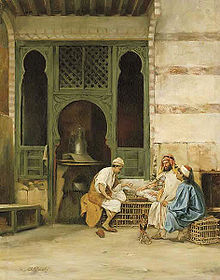
After the end of the 19th century, the number of master tournaments and matches held annually quickly grew. Some sources state that in 1914 the title of chess Grandmaster was first formally conferred by Tsar Nicholas II of Russia to Lasker, Capablanca, Alekhine, Tarrasch, and Marshall, but this is a disputed claim. The tradition of awarding such titles was continued by the World Chess Federation ( FIDE), founded in 1924 in Paris. In 1927, the Women's World Chess Championship was established; the first to hold the title was Czech-English master Vera Menchik. It took a prodigy from Cuba, José Raúl Capablanca (World Champion 1921–27), who loved simple positions and endgames, to end the German-speaking dominance in chess; he was undefeated in tournament play for eight years, until 1924. His successor was Russian-French Alexander Alekhine, a strong attacking player who died as the World champion in 1946. He briefly lost the title to Dutch player Max Euwe in 1935 and regained it two years later.
Between the world wars, chess was revolutionized by the new theoretical school of so-called hypermodernists like Aron Nimzowitsch and Richard Réti. They advocated controlling the center of the board with distant pieces rather than with pawns, which invited opponents to occupy the centre with pawns, which become objects of attack.
Post-war era (1945 and later)
After the death of Alekhine, a new World Champion was sought. FIDE, who have controlled the title since then (except for one interruption), ran a tournament of elite players. The winner of the 1948 tournament, Russian Mikhail Botvinnik, started an era of Soviet dominance in the chess world. Until the end of the Soviet Union, there was only one non-Soviet champion, American Bobby Fischer (champion 1972–75). Botvinnik revolutionized opening theory. Previously Black strove for equality, to neutralize White's first-move advantage. As Black, Botvinnik strove for the initiative from the beginning. In the previous informal system of World Championships, the current champion decided which challenger he would play for the title and the challenger was forced to seek sponsors for the match. FIDE set up a new system of qualifying tournaments and matches. The world's strongest players were seeded into Interzonal tournaments, where they were joined by players who had qualified from Zonal tournaments. The leading finishers in these Interzonals would go on the " Candidates" stage, which was initially a tournament, and later a series of knockout matches. The winner of the Candidates would then play the reigning champion for the title. A champion defeated in a match had a right to play a rematch a year later. This system operated on a three-year cycle. Botvinnik participated in championship matches over a period of fifteen years. He won the world championship tournament in 1948 and retained the title in tied matches in 1951 and 1954. In 1957, he lost to Vasily Smyslov, but regained the title in a rematch in 1958. In 1960, he lost the title to the 23-year-old Latvian prodigy Mikhail Tal, an accomplished tactician and attacking player. Botvinnik again regained the title in a rematch in 1961.
Following the 1961 event, FIDE abolished the automatic right of a deposed champion to a rematch, and the next champion, Armenian Tigran Petrosian, a player renowned for his defensive and positional skills, held the title for two cycles, 1963–69. His successor, Boris Spassky from Russia (champion 1969–72), won games in both positional and sharp tactical style. The next championship, the so-called Match of the Century, saw the first non-Soviet challenger since World War II, American Bobby Fischer, who defeated his Candidates opponents by unheard-of margins and clearly won the world championship match. In 1975, however, Fischer refused to defend his title against Soviet Anatoly Karpov when FIDE did not meet his demands, and Karpov obtained the title by default. Fischer modernized many aspects of chess, especially by extensively preparing openings.
Karpov defended his title twice against Viktor Korchnoi and dominated the 1970s and early 1980s with a string of tournament successes. Karpov's reign finally ended in 1985 at the hands of Garry Kasparov, another Soviet player from Baku, Azerbaijan. Kasparov and Karpov contested five world title matches between 1984 and 1990; Karpov never won his title back. In 1993, Garry Kasparov and Nigel Short broke with FIDE to organize their own match for the title and formed a competing Professional Chess Association (PCA). From then until 2006, there were two simultaneous World Champions and World Championships: the PCA or Classical champion extending the Steinitzian tradition in which the current champion plays a challenger in a series of many games, and the other following FIDE's new format of many players competing in a tournament to determine the champion. Kasparov lost his Classical title in 2000 to Vladimir Kramnik of Russia. The World Chess Championship 2006, in which Kramnik beat the FIDE World Champion Veselin Topalov, reunified the titles and made Kramnik the undisputed World Chess Champion. In September 2007, he lost the title to Viswanathan Anand of India, who won the championship tournament in Mexico City. Anand defended his title in the revenge match of 2008.
Place in culture
Pre-modern
In the Middle Ages and during the Renaissance, chess was a part of noble culture; it was used to teach war strategy and was dubbed the " King's Game". Gentlemen are "to be meanly seene in the play at Chestes", says the overview at the beginning of Baldassare Castiglione's The Book of the Courtier (1528, English 1561 by Sir Thomas Hoby), but chess should not be a gentleman's main passion. Castiglione explains it further:
And what say you to the game at chestes? It is truely an honest kynde of enterteynmente and wittie, quoth Syr Friderick. But me think it hath a fault, whiche is, that a man may be to couning at it, for who ever will be excellent in the playe of chestes, I beleave he must beestowe much tyme about it, and applie it with so much study, that a man may assoone learne some noble scyence, or compase any other matter of importaunce, and yet in the ende in beestowing all that laboure, he knoweth no more but a game. Therfore in this I beleave there happeneth a very rare thing, namely, that the meane is more commendable, then the excellency.
Many of the elaborate chess sets used by the aristocracy have been lost, but others partially survive, such as the Lewis chessmen.
Chess was often used as a basis of sermons on morality. An example is Liber de moribus hominum et officiis nobilium sive super ludo scacchorum ('Book of the customs of men and the duties of nobles or the Book of Chess'), written by an Italian Dominican monk Jacobus de Cessolis c. 1300. This book was one of the most popular of the Middle Ages. The work was translated into many other languages (the first printed edition was published at Utrecht in 1473) and was the basis for William Caxton's The Game and Playe of the Chesse (1474), one of the first books printed in English. Different chess pieces were used as metaphors for different classes of people, and human duties were derived from the rules of the game or from visual properties of the chess pieces:
The knyght ought to be made alle armed upon an hors in suche wyse that he haue an helme on his heed and a spere in his ryght hande/ and coueryd wyth his sheld/ a swerde and a mace on his lyft syde/ Cladd wyth an hawberk and plates to fore his breste/ legge harnoys on his legges/ Spores on his heelis on his handes his gauntelettes/ his hors well broken and taught and apte to bataylle and couerid with his armes/ whan the knyghtes ben maad they ben bayned or bathed/ that is the signe that they shold lede a newe lyf and newe maners/ also they wake alle the nyght in prayers and orysons vnto god that he wylle gyue hem grace that they may gete that thynge that they may not gete by nature/ The kynge or prynce gyrdeth a boute them a swerde in signe/ that they shold abyde and kepe hym of whom they take theyr dispenses and dignyte.
Known in the circles of clerics, students, and merchants, chess entered into the popular culture of Middle Ages. An example is the 209th song of Carmina Burana from the 13th century, which starts with the names of chess pieces, Roch, pedites, regina...
Modern
During the Age of Enlightenment, chess was viewed as a means of self-improvement. Benjamin Franklin, in his article "The Morals of Chess" (1750), wrote:
"The Game of Chess is not merely an idle amusement; several very valuable qualities of the mind, useful in the course of human life, are to be acquired and strengthened by it, so as to become habits ready on all occasions; for life is a kind of Chess, in which we have often points to gain, and competitors or adversaries to contend with, and in which there is a vast variety of good and ill events, that are, in some degree, the effect of prudence, or the want of it. By playing at Chess then, we may learn: I. Foresight, which looks a little into futurity, and considers the consequences that may attend an action [...] II. Circumspection, which surveys the whole Chess-board, or scene of action: – the relation of the several Pieces, and their situations [...] III. Caution, not to make our moves too hastily [...]"
With these or similar hopes, chess is taught to children in schools around the world today. Many schools host chess clubs, and there are many scholastic tournaments specifically for children. Tournaments are held regularly in many countries, hosted by organizations such as the United States Chess Federation and the National Scholastic Chess Foundation.
Chess is often depicted in the arts; significant works where chess plays a key role range from Thomas Middleton's A Game at Chess to Through the Looking-Glass by Lewis Carroll to The Royal Game by Stefan Zweig and Vladimir Nabokov's The Defense. The thriller film Knight Moves is about a chess grandmaster who is accused of being a serial killer. Chess is featured in films like Ingmar Bergman's The Seventh Seal and Satyajit Ray's The Chess Players. Chess is also present in the contemporary popular culture. For example, J. K. Rowling's Harry Potter plays " Wizard's Chess", while the characters of Star Trek prefer " Tri-Dimensional Chess". The hero of Searching for Bobby Fischer struggles against adopting the aggressive and misanthropic views of a world chess champion. Chess has been used as the core theme of a musical, Chess, by Tim Rice, Björn Ulvaeus, and Benny Andersson.
Composition
Chess composition is the art of creating chess problems (the problems themselves are sometimes also called chess compositions). A person who creates such problems is known as a chess composer. There are many types of chess problems. The two most important are:
- Directmates: white to move first and checkmate black within a specified number of moves against any defense. These are often referred to as "mate in n" – for example "mate in three" (a three-mover).
- Studies: orthodox problems in which the stipulation is that white to play must win or draw. Almost all studies are endgame positions.
Chess composition is a distinct branch of chess sport, and tournaments (or tourneys) exist for both the composition and solving of chess problems.
Example
Ostrauer Morgenzeitung, 4 Dec. 1921
This is one of the most famous chess studies; it was published by Richard Réti in 1921. It seems impossible to catch the advanced black pawn, while the black king can easily stop the white pawn. The solution is a diagonal advance, which brings the king to both pawns simultaneously:
1. Kg7! h4
2. Kf6! Kb6
- Or 2...h3 3.Ke7 and the white king can support its pawn.
3. Ke5!!
- Now the white king comes just in time to support his pawn, or catch the black one.
3... h3
4. Kd6 draw
Competitive play
Organization of competitions
Contemporary chess is an organized sport with structured international and national leagues, tournaments, and congresses. Chess's international governing body is FIDE (Fédération Internationale des Échecs). Most countries have a national chess organization as well (such as the US Chess Federation and English Chess Federation) which in turn is a member of FIDE. FIDE is a member of the International Olympic Committee, but the game of chess has never been part of the Olympic Games; chess does have its own Olympiad, held every two years as a team event.
The current World Chess Champion is Viswanathan Anand of India. The reigning Women's World Champion is Anna Ushenina from Ukraine. The world's highest rated female player, Judit Polgár, has never participated in the Women's World Chess Championship, instead preferring to compete with the leading men and maintaining a ranking among the top male players.
Other competitions for individuals include the World Junior Chess Championship, the European Individual Chess Championship, and the National Chess Championships. Invitation-only tournaments regularly attract the world's strongest players. Examples include Spain's Linares event, Monte Carlo's Melody Amber tournament, the Dortmund Sparkassen meeting, Sofia's M-tel Masters, and Wijk aan Zee's Tata Steel tournament.
Regular team chess events include the Chess Olympiad and the European Team Chess Championship. The 38th Chess Olympiad was held 2008 in Dresden, Germany; Armenia won the gold in the unrestricted event for the second time in a row after Turin 2006, and Georgia took the top medal for the women. The World Chess Solving Championship and World Correspondence Chess Championships include both team and individual events.
Besides these prestigious competitions, there are thousands of other chess tournaments, matches, and festivals held around the world every year catering to players of all levels. Chess is promoted as a "mind sport" by the Mind Sports Organisation, alongside other mental-skill games such as Contract Bridge, Go, and Scrabble.
Titles and rankings
The best players can be awarded specific lifetime titles by the world chess organization FIDE:
- Grandmaster (shortened as GM; sometimes International Grandmaster or IGM is used) is awarded to world-class chess masters. Apart from World Champion, Grandmaster is the highest title a chess player can attain. Before FIDE will confer the title on a player, the player must have an Elo chess rating (see below) of at least 2500 at one time and three favorable results (called norms) in tournaments involving other grandmasters, including some from countries other than the applicant's. There are other milestones a player can achieve to attain the title, such as winning the World Junior Championship.
- International Master (shortened as IM). The conditions are similar to GM, but less demanding. The minimum rating for the IM title is 2400.
- FIDE Master (shortened as FM). The usual way for a player to qualify for the FIDE Master title is by achieving a FIDE rating of 2300 or more.
- Candidate Master (shortened as CM). Similar to FM, but with a FIDE rating of at least 2200.
All the titles are open to men and women. Separate women-only titles, such as Woman Grandmaster (WGM), are available. Beginning with Nona Gaprindashvili in 1978, a number of women have earned the GM title, and most of the top ten women in 2006 hold the unrestricted GM title.
As of August 2011, there are 1363 active grandmasters and 3153 international masters in the world. Top three countries with the largest numbers of grandmasters are Russia, Ukraine, and Germany, with 208, 78, and 76. The country with most grandmasters per capita is Iceland, with 11 GMs and 13 IMs among the population of 310,000.
International titles are awarded to composers and solvers of chess problems and to correspondence chess players (by the International Correspondence Chess Federation). National chess organizations may also award titles, usually to the advanced players still under the level needed for international titles; an example is the Chess expert title used in the United States.
In order to rank players, FIDE, ICCF, and national chess organizations use the Elo rating system developed by Arpad Elo. Elo is a statistical system based on the assumption that the chess performance of each player in their games is a random variable. Arpad Elo thought of a player's true skill as the average of that player's performance random variable, and showed how to estimate the average from results of player's games. The US Chess Federation implemented Elo's suggestions in 1960, and the system quickly gained recognition as being both fairer and more accurate than older systems; it was adopted by FIDE in 1970. The highest FIDE rating of all time, 2861, was achieved by Magnus Carlsen on the January 2013 FIDE rating list.
Publications
Chess has a very extensive literature. In 1913, the chess historian H.J.R. Murray estimated the total number of books, magazines, and chess columns in newspapers to be about 5,000. B.H. Wood estimated the number, as of 1949, to be about 20,000. David Hooper and Kenneth Whyld write that, "Since then there has been a steady increase year by year of the number of new chess publications. No one knows how many have been printed." There are two significant public chess libraries: the John G. White Chess and Checkers Collection at Cleveland Public Library, with over 32,000 chess books and over 6,000 bound volumes of chess periodicals; and the Chess & Draughts collection at the National Library of the Netherlands, with about 30,000 books. Grandmaster Lothar Schmid owns the world's largest private collection of chess books and memorabilia. David DeLucia's chess library contains 7,000 to 8,000 chess books, a similar number of autographs (letters, score sheets, manuscripts), and about 1,000 items of "ephemera". Ten Geuzendam opines that DeLucia's collection "is arguably the finest chess collection in the world".
Mathematics and computers
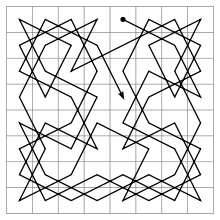
The game structure and nature of chess is related to several branches of mathematics. Many combinatorical and topological problems connected to chess were known of for hundreds of years. In 1913, Ernst Zermelo used chess as a basis for his theory of game strategies, which is considered as one of the predecessors of game theory.
The number of legal positions in chess is estimated to be between 1043 and 1047 (a provable upper bound), with a game-tree complexity of approximately 10123. The game-tree complexity of chess was first calculated by Claude Shannon as 10120, a number known as the Shannon number. Typically an average position has thirty to forty possible moves, but there may be as few as zero (in the case of checkmate or stalemate) or as many as 218.
One of the most important mathematical challenges of chess is the development of algorithms that can play chess. The idea of creating a chess-playing machine dates to the 18th century; around 1769, the chess-playing automaton called The Turk became famous before being exposed as a hoax. Serious trials based on automatons, such as El Ajedrecista, were too complex and limited to be useful.
Since the advent of the digital computer in the 1950s, chess enthusiasts, computer engineers and computer scientists have built, with increasing degrees of seriousness and success, chess-playing machines and computer programs. The groundbreaking paper on computer chess, "Programming a Computer for Playing Chess", was published in 1950 by Shannon. He wrote:
The chess machine is an ideal one to start with, since: (1) the problem is sharply defined both in allowed operations (the moves) and in the ultimate goal (checkmate); (2) it is neither so simple as to be trivial nor too difficult for satisfactory solution; (3) chess is generally considered to require "thinking" for skillful play; a solution of this problem will force us either to admit the possibility of a mechanized thinking or to further restrict our concept of "thinking"; (4) the discrete structure of chess fits well into the digital nature of modern computers.
The Association for Computing Machinery (ACM) held the first major chess tournament for computers, the North American Computer Chess Championship, in September 1970. CHESS 3.0, a chess program from Northwestern University, won the championship. Nowadays, chess programs compete in the World Computer Chess Championship, held annually since 1974. At first considered only a curiosity, the best chess playing programs, for example Rybka, have become extremely strong. In 1997, a computer won a chess match against a reigning World Champion for the first time: IBM's Deep Blue beat Garry Kasparov 3½–2½ (it scored two wins, one loss, and three draws). In 2009, a mobile phone won a category 6 tournament with a performance rating 2898: chess engine Hiarcs 13 running on the mobile phone HTC Touch HD won the Copa Mercosur tournament with nine wins and one draw. The best chess programs are now able to beat the strongest human players.
With huge databases of past games and high analytical ability, computers can help players to learn chess and prepare for matches. Internet Chess Servers allow people to find and play opponents all over the world. The presence of computers and modern communication tools have raised concerns regarding cheating during games, most notably the " bathroom controversy" during the 2006 World Championship.
Zermelo's theorem states that it is possible to solve chess, i. e. to determine with certainty the outcome of a perfectly played game (namely that if the game cannot end in a draw, then one of the two players must have a winning strategy). However, according to Claude Shannon, the timeframe required puts this possibility beyond the limits of any feasible technology. It is unknown whether an indirect proof of the outcome of a perfectly played game exists. In other words, it is not known whether or not it is possible to determine the outcome without determining the optimal strategy itself.
Psychology
There is an extensive scientific literature on chess psychology. Alfred Binet and others showed that knowledge and verbal, rather than visuospatial, ability lies at the core of expertise. In his doctoral thesis, Adriaan de Groot showed that chess masters can rapidly perceive the key features of a position. According to de Groot, this perception, made possible by years of practice and study, is more important than the sheer ability to anticipate moves. De Groot showed that chess masters can memorize positions shown for a few seconds almost perfectly. The ability to memorize does not alone account for chess-playing skill, since masters and novices, when faced with random arrangements of chess pieces, had equivalent recall (about half a dozen positions in each case). Rather, it is the ability to recognize patterns, which are then memorized, which distinguished the skilled players from the novices. When the positions of the pieces were taken from an actual game, the masters had almost total positional recall.
More recent research has focused on chess as mental training; the respective roles of knowledge and look-ahead search; brain imaging studies of chess masters and novices; blindfold chess; the role of personality and intelligence in chess skill; gender differences; and computational models of chess expertise. The role of practice and talent in the development of chess and other domains of expertise has led to a lot of research recently. Ericsson and colleagues have argued that deliberate practice is sufficient for reaching high levels of expertise in chess. Recent research indicates that factors other than practice are also important. For example, Fernand Gobet and colleagues have shown that stronger players started playing chess at a young age and that experts born in the Northern Hemisphere are more likely to have been born in late winter and early spring. Chess players are more likely to be non-right-handed, though they found no correlation between handedness and skill.
Chess and intelligence
Although the link between performance in chess and general intelligence is often assumed, researchers have largely failed to confirm its existence. For example, a 2006 study found no differences in fluid intelligence, as measured by Raven's Progressive Matrices, between strong adult chess players and regular people. There is some evidence towards a correlation between performance in chess and intelligence among beginning players. However, performance in chess also relies substantially on one's amount of experience playing the game, and the role of experience may overwhelm the role of intelligence. Chess experts are estimated to have in excess of 10,000 and possibly as many as 300,000 position patterns stored in their memory; prolonged training is necessary to acquire that amount of data.
A 2007 study of young chess players in the United Kingdom found that strong players tended to have above-average IQ scores, but, within that group, the correlation between chess skill and IQ was actually moderately negative, meaning that smarter children tended to achieve a lower level of chess skill. This result was explained by the fact that there was a negative correlation between intelligence and practice in the elite subsample, and that practice had a higher influence on chess skill.
Variants
Chess variants are forms of chess where the game is played using a different board (e.g. hexagonal chess or 3D chess), different rules, or special fairy pieces. There are more than two thousand published variants, the most popular being xiangqi in China and shogi in Japan. Chess variants can include, but are not limited to:
- direct predecessors of chess ( chaturanga and shatranj);
- traditional national or regional variants like xiangqi, shogi, janggi (Korea), and makruk (Thailand), which share common predecessors with Western chess;
- modern variants such as Chess960, where the starting position is selected randomly, rendering advance preparation of opening lines impracticable and compelling players to rely on their talent and creativity.

